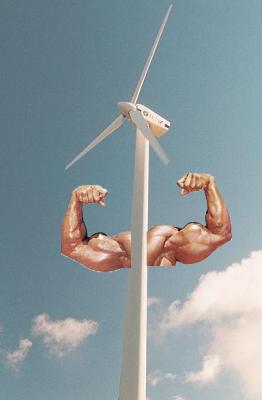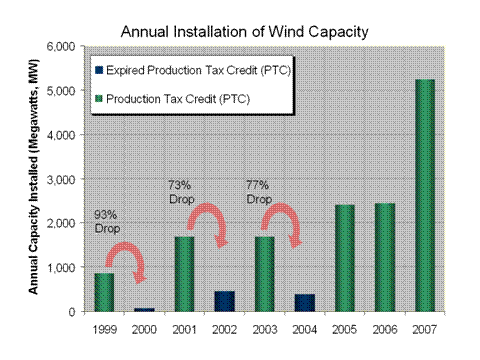 Shattering all its previous records, the U.S. wind energy industry installed 5,244 megawatts (MW) in 2007, expanding the nation’s total wind power generating capacity by 45% in a single calendar year and injecting an investment of over $9 billion into the economy, the American Wind Energy Association (AWEA) announced today. The new wind projects account for about 30% of the entire new power-producing capacity added nationally in 2007 and will power the equivalent of 1.5 million American households annually while strengthening U.S. energy supply with clean, homegrown electric power.
Shattering all its previous records, the U.S. wind energy industry installed 5,244 megawatts (MW) in 2007, expanding the nation’s total wind power generating capacity by 45% in a single calendar year and injecting an investment of over $9 billion into the economy, the American Wind Energy Association (AWEA) announced today. The new wind projects account for about 30% of the entire new power-producing capacity added nationally in 2007 and will power the equivalent of 1.5 million American households annually while strengthening U.S. energy supply with clean, homegrown electric power.
“This is the third consecutive year of record-setting growth, establishing wind power as one of the largest sources of new electricity supply for the country,†said AWEA Executive Director Randall Swisher. “This remarkable and accelerating growth is driven by strong demand, favorable economics, and a period of welcome relief from the on-again, off-again, boom-and-bust, cycle of the federal production tax credit (PTC) for wind power.â€
“But the PTC and tax incentives for other renewable energy sources are now in danger of lapsing at the end of this year—and at the worst moment for the U.S economy,†added Swisher. “The U.S. wind industry calls on Congress and the President to quickly extend the PTC—the only existing U.S. incentive for wind power—in order to sustain this remarkable growth along with the manufacturing jobs, fresh economic opportunities, and reduction of global warming pollution that it provides.â€
The U.S. wind power fleet now numbers 16,818 MW and spans 34 states. American wind farms will generate an estimated 48 billion kilowatt-hours (kWh) of wind energy in 2008, just over 1% of U.S. electricity supply, powering the equivalent of over 4.5 million homes.
This wind power also:
- Helps protect consumers from increases in electricity costs due to volatile fuel prices and supply disruptions: by reducing the use of natural gas and other fuels used for electricity generation, and lowering the pressure on their price, wind can save consumers money, even in regions with low or no wind resources.
- Reduces global warming emissions: To generate the same amount of electricity using the average U.S. power plant fuel mix would cause over 28 million tons of carbon dioxide (CO2) to be emitted annually.
- Conserves precious water resources: Wind farms don’t need water for steam or for cooling, a benefit that is increasingly valuable in arid areas and in times of drought.
Wind power’s strong performance is expected to continue this year, with AWEA’s initial estimates indicating that 2008 could equal 2007 in new wind capacity installed. Developers report that with strong demand for wind power across the country, wind turbines are already sold out for the year. Talk about an opporotunity, if more companies in America started making wind turbines they could be sold out before they were done. AWEA projects that with more companies entering the market, more turbines will become available. The pace of growth in 2008 and beyond is expected to largely depend, not on turbine availability, but on the timing and duration of an extension of the federal production tax credit.
The following chart illustrates the impacts of the expiration-and-extension cycles of the production tax credit on annual wind power installations and shows how stability in the availability of the credit spurs growth.

Report highlights include:
Installations in the last quarter of 2007 alone (2,930 MW) surpassed the amount installed in all of 2006 (2,454 MW).
Texas consolidates its lead; wind power also expands at a strong pace in Midwest and Northwest. The states with the most cumulative wind power capacity installed are:
Texas – 4356 MW
California – 2439 MW
Minnesota – 1299 MW
Iowa – 1273 MW
Washington – 1163 MW
Investment is flowing into the wind power supply chain.
At least fourteen new manufacturing facilities opened or were announced in 2007, according to initial AWEA estimates. Companies are opening new manufacturing plants and expanding existing ones, creating new jobs and business opportunities across the country, even in states that do not have a large wind resource.
GE Energy continued to lead in wind turbine sales, with 45% of the market in terms of new capacity installed. FPL Energy remained atop the list of wind project developers, with 956 MW of new development in 2007 alone.
The full annual report is available here and a state-by-state listing of existing and proposed wind energy projects is available at http://www.awea.org/projects.
Neat graphic!
Regards,
Thomas O. Gray
American Wind Energy Association
http://www.powerofwind.org
http://www.awea.org
Shouldn’t um.. profit be another incentive for installing wind generation? The author seems to be in favor of extending tax credits to the wind power interests… At what point will they be able to swim without tax-payer purchased water wings?
Well… I’m sure they will let us know.
Oh and, the article makes no mention of the actual amount of power generated by the wind turbines, just the “capacity installed”. That is so very useful.
– Profit is a part of every business, including wind.
– The bulk of federal energy subsidies, tax breaks, etc., continue to flow to the fossil fuels industries. Fossil fuels get an extra boost because they are “subsidized” by not having to pay their full environmental costs. Until these factors change, there’s not much justification for removing support from clean energy.
– The article does in fact mention the electricity production–48 billion kWh in 2008, equivalent to the usage of 4.5 million average households (with 12 million people.
Regards,
Regards,
Thomas O. Gray
American Wind Energy Association
http://www.powerofwind.org
http://www.awea.org
Did 2008 already happen? My it’s been a quick year.
Why does the AWEA lobby for it’s own subsidies but not for an end to oil subsidies?
Are wind turbines made from recycled or up-cycleable materials?
Are the maintenance crews riding bicycles to and from the wind farms? Just how clean is “clean”?
With just a little critical thought, it is obvious that the wind energy, on the whole, does consume resources, including fossil fuels. Prove to me that wind energy, on the whole, produces less emmisions/MWh than nuclear or fossil fuel power, and you’ll have another believer. I suspect, you’ll also have a truly profitable industry as well.
HI I WANT TO SAVE THE EARTH CAN WE
Hi Rachael,
Sorry, we don’t have time for that, we are too busy making the perfect the enemy of the good. 8^(
uwjames:
– Gosh, you are right, 2008 didn’t happen yet. The amount of electricity that will be generated is a reasonable forecast, based upon what we know of the productivity of existing wind projects. If you feel like it, though, you can go digging at the Energy Information Administration Web site and see what they are reporting for wind electricity production.
– We don’t lobby against oil subsidies because it’s a fight that cannot be won. What is politically doable is to ask for our own support. But let me turn the question around: why are you so interested in going after wind instead of more polluting energy resources? Are you ripping up other energy subsidies somewhere else?
– “Critical” thought is the right phrase. Yes, manufacturing a wind turbine or building a wind farm requires energy, but the energy payback of wind projects (ratio of energy out to energy in) is one of the highest for energy technologies–between 40:1 and 60:1, depending on whose estimate one takes. Here is an example of one of several studies that have come to similar results.
Regards,
Thomas O. Gray
American Wind Energy Association
http://www.powerofwind.org
http://www.awea.org
Tom, thanks for having an open discussion. Concerned citizens certainly don’t get these kind of opportunities with the oil and coal lobbies.
First off, I did look at the EIA website, but unfortunately their latest hard numbers are for 2005.
Also, I did something that I should have done in the first place. I figured out exactly what the PTC is.. Well, it’s basically 1.9 cents for every kWh generated. If we accept the AWEA projections, that comes out to 900M dollars. I wonder why this was not stated in the article.
It is true that wind turbines quickly pay off their energy costs, but this says nothing about the dollar cost of wind power, which according to this article comes to about $1700 per kW of capacity. Quite a high price when you consider that wind turbines, on average, operate at less than 50% capacity. I think the average household could decrease their energy footprint by a kW for a lot less…
Sexy facts do make it easier to sell alternative energy sources to the public. People seem to think that everything will be OK if their wasteful, inefficient lifestyles were fueled by windmills and corn, instead of coal and oil. The truth is, it wont matter how we power our society if we don’t change our lifestyles.
REDUCE REUSE and RECYCLE
You’re welcome. Not sure how long I will be around, as dialogues on blogs could easily be a full-time job–I had to give up blogging last year in favor of more essential duties.
– Re EIA: Correct, their numbers are never current, but they are about the only authoritative game in town. Some states do publish annual generation numbers … In the past, though, EIA’s numbers have matched up pretty well with ours.
– $900m for this year is about right. Why didn’t we include it? To be candid, it’s not a selling point, but we also didn’t mention the $30-40 billion that the federal government spends each year subsidizing conventional, polluting energy technologies that have been around for 50-100 years, or the fact that total federal spending is now nearly $3 trillion per year (of which that $900 million will amount to one-thirtieth of one percent).
– $1,700/kW and less than 50% (more like 35%) are both correct. Your analysis, however, omits fuel costs, which are both substantial and wildly unpredictable for sources like fossil fuels (that currently supply ~70% of our electricity). Wind’s fuel costs are zero and predictable.
– I agree that our lifestyles need to change (we have all CF bulbs in our house, heat with wood, and drive hybrids). But regardless of whether they do, it still matters hugely whether we are getting our electricity–and other energy–from sources that contribute to global warming or from sources that do not.
Regards,
Thomas O. Gray
American Wind Energy Association
http://www.powerofwind.org
http://www.awea.org